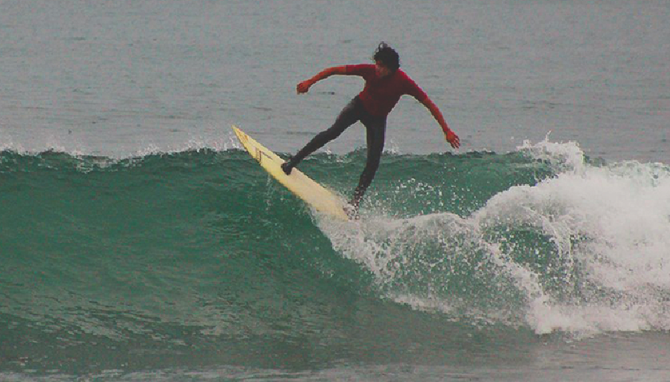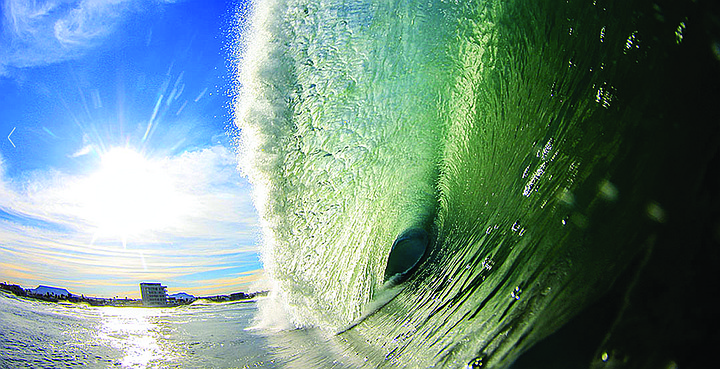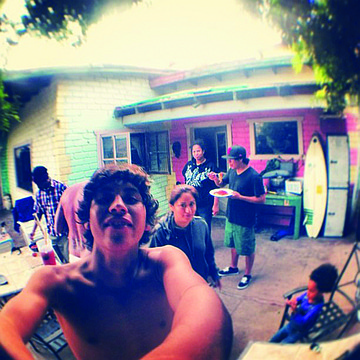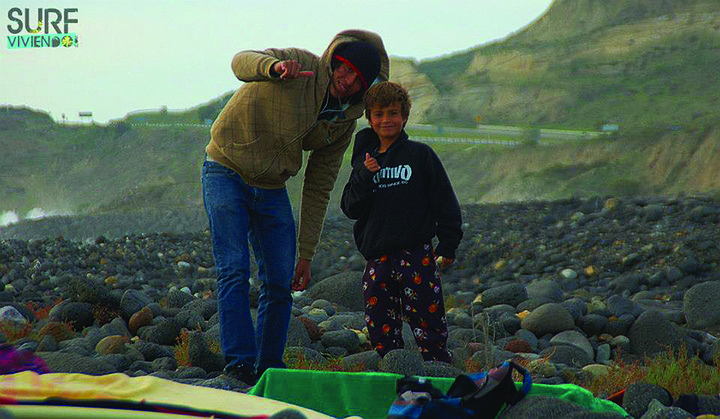 Facebook
Facebook
 X
X
 Instagram
Instagram
 TikTok
TikTok
 Youtube
Youtube

Banano
“I learned to surf with a broken board. I repaired it with resin that I bought from a fish taxidermist factory. I patched it and I glued it back together. I would surf with a ripped-up leash that I sewed back together with wire and covered it with electrical tape. I would not wear a wetsuit because I didn’t have the money to buy one, and even if I did, back then Rosarito was a rancho and there were none for sale anywhere. If you were lucky at the Sunday flea market, you would find a used heavy scuba diving wetsuit or a two-piece one made for jet-skiing. I could not even afford surf wax, so I would light my mom’s candles and pour the melted wax right on the board.”
Rosarito’s Juan Ramón Aguirre (a.k.a. Banano) started surfing back in 1986, when he was only 11 (he is now 38 and still surfs). At that time, he would hitchhike with a patched-up board under his arm, stopping for breakfast at a beach-side bakery where he’d buy a freshly baked bolillo roll and a bottle of juice. Right after, he was off to the ocean with a couple of surf buddies who were about his age. There was no surf forecast back then, and the only wave-prediction tool they had was a tide table. They didn’t care if it was windy or cold; they didn’t care if it rained. Many times, their belongings were stolen while they were in the water. None of the surfers back then took surf classes; they didn’t have the support of their parents. They didn’t enter contests; nobody took pictures of them surfing. They didn’t even have the right equipment for the furious currents and the icy water, but one thing was clear: they loved the ocean and nothing would stop them from surfing.
Polo
The first surfers to ride the waves in Baja came from California in the ’60s, but it wasn’t until the ’70s that Rosarito became a popular surfing spot. Today, Hipólito González (a.k.a. Polo) is 50 years old and a lifeguard, still surfing and regularly attending national tournaments in Mexico. Polo’s generation had emblematic local surfers such as Tony E., Negro Mirón, Ricardo Alzalde, Osvaldo Chavez, Ricardo Farfán, among many others. He started surfing in 1978. When he was little, his favorite route to walk to school was on the beach. That’s how he saw men on the waves for the first time in his life. He was one of the first kids who gave a second chance to an abandoned surfboard broken in half. It was with one of those boards that he taught himself to surf.

Polo knows the Rosarito beaches like the palm of his hand. He explains, “In Rosarito there are many surfing spots, some for locals and others for gabachos: gabachos really like Baja Malibú, Marysol, and both sides of the Pemex power plant. Right now, many pro surfers surf by the power plant; they get towed in with a jet-ski. It’s a point [break]. They do a lot of magazine features at this spot, but it’s hidden. It’s a secret; they never say where it’s located. The locals like to surf by the park, by the Villas del Mar, the Quinta del Mar, the Hotel Rosarito pier, or in the south: Popotla, Chivos, K36, Teresitas or El Morro, K38, K55, Alisitos, and La Fonda. My favorite point right now is the pier because the waves here are great, unlike other places on the main beach where they’re beach break.”
Vicente (a.k.a. Botz)
Young and old surfers with beach-blond hair wearing buttoned-up flannel shirts stand respectfully in front of a church where a double funeral is being held. No one says much. They are here to support their friend and fellow surfer Vicente, who is going through a rough time.

Vicente Aldaz Corona lived with his parents and his four younger siblings in front of Alisitos Beach (K59½); he has been surfing for the past ten years, since he was eight years old. At first his parents were apprehensive about their son’s new passion. They thought surfing was too dangerous, but over time, they saw how happy it made their son, and they learned to like it and respect it. Especially his mom, Angela, who would sell snacks and food in order to raise money to help Vicente go to state and national tournaments. But everything changed for Vicente at the beginning of this summer, when his parents died in a car crash. His 12-year-old sister, Kenia, was in the car with them. She was injured very badly and fell into a coma.
Now Vicente and his siblings will have to move to Tijuana with their grandparents. Since he is the oldest son, he has big responsibilities: now he will have to look after his siblings. But he plans on getting back to surfing as soon as he is able. He explains, “The sea is my support, and I know I can always go visit my old neighbors at La Fonda and Alisitos, but I can’t live there anymore. I need to work and study and take care of my siblings. It was very important for my parents that I stayed in school, so that’s what I’ll do. And although in the ocean I lose all my stress and I feel free and happy, I have to think of my siblings before I think of me.” (Kenia is doing much better and there is good reason to believe that she will make a full recovery.)
Luna
Carlos Luna almost became a lawyer. He was in law school for three and a half years, but one day he felt like it was just a waste of time, so he dropped out and became a lifeguard. Luna and his buddy, José Luis Ames Santana (who was also a lifeguard), dreamed of opening a surf school in Rosarito. In 2005 they founded Escuela de Surf Locales. In the beginning they focused on classes for tourists, but Carlos noticed that the local kids really wanted to learn to surf, but they couldn’t afford classes or equipment. He then thought of a way to offer classes to underprivileged kids by trying to get government funding. He also discovered that surfing was a way to give a sense of community and identity to kids who were originally from other parts of Mexico and who now live in Rosarito.
Today, Carlos offers private classes and also volunteers his time to give free classes to kids from the community. All of the classes have high safety standards and include all the equipment. The school also offers a surf summer camp where boys and girls learn to surf, do yoga, learn about the environment, learn first aid, learn about art, and learn swimming and surf techniques.
In the old days, surfers excluded women, but in early 2000, Yolanda Blanco, Kenia León, Alejandra Pérez, and Marisela Martín del Campo became the first generation of women to take to the waves. Now there are at least 12 young girls surfing and competing in tournaments in Rosarito; all of them learned to surf at the Locales surf school.
Luna is also the president of the Asociación de Surfing de Baja California and he is organizing the Torneo Nacional de Surf, which will be held from September 1 through September 8 in Rosarito. The asociación is getting ready to welcome 400 surfers from all over Mexico.
Luna has a lot of plans for the future: he wants to go back to school and get a bachelor’s degree in physical education. He also wants to broaden the reach of the surf school by adding programs for kids with autism and obesity because, as he says, “Anyone can surf. In Rosarito there are waves for everyone all year long. We are very lucky.”
Joshua Estrada
Joshua traveled alone for the first time in June, going to a Red Bull–sponsored surf camp in El Salvador to join the most promising young surfers in Latin America. At only nine years old, he was the youngest of them all.

Joshua is a lively kid who can only stand still when he’s watching the waves, completely absorbed by their power and beauty. At his young age, he has mastered a five-foot-long shortboard and has won many trophies. He’s well traveled and has been to local, state, national, and international tournaments. He is a promising surfer, a talented figure, and a symbol of pride for Rosarito, his hometown. He says: “I surf the coldest waves of Mexico, in the strongest currents. I really like to surf because it relaxes you and you can forget about everything when you are surfing.”
His parents support him in every way they can, but he also gets a lot of support and help from other surfers, such as Tony Loza, Jorge Lopez, Carlos Luna, and many more. He has been surfing since he was seven and today he is well-known within the Rosarito surf community.
Rosarito’s surf is still fairly unknown, and it’s worth discovering it. Banano says: “Once I grew up and was able to travel, I surfed in Oaxaca, Nayarit, Puerto Vallarta, I’ve surfed all over Baja and on the California coast, but every time I came back, I appreciated my hometown even more. In the United States, the waves are crowded. There’s no way you’ll have a perfect set to yourself, but here, you have lefts, rights, tubes, points, offshore winds, and even beach break, if that’s what you like. You can surf all day and be the only one in the waves. It’s great.”


Banano
“I learned to surf with a broken board. I repaired it with resin that I bought from a fish taxidermist factory. I patched it and I glued it back together. I would surf with a ripped-up leash that I sewed back together with wire and covered it with electrical tape. I would not wear a wetsuit because I didn’t have the money to buy one, and even if I did, back then Rosarito was a rancho and there were none for sale anywhere. If you were lucky at the Sunday flea market, you would find a used heavy scuba diving wetsuit or a two-piece one made for jet-skiing. I could not even afford surf wax, so I would light my mom’s candles and pour the melted wax right on the board.”
Rosarito’s Juan Ramón Aguirre (a.k.a. Banano) started surfing back in 1986, when he was only 11 (he is now 38 and still surfs). At that time, he would hitchhike with a patched-up board under his arm, stopping for breakfast at a beach-side bakery where he’d buy a freshly baked bolillo roll and a bottle of juice. Right after, he was off to the ocean with a couple of surf buddies who were about his age. There was no surf forecast back then, and the only wave-prediction tool they had was a tide table. They didn’t care if it was windy or cold; they didn’t care if it rained. Many times, their belongings were stolen while they were in the water. None of the surfers back then took surf classes; they didn’t have the support of their parents. They didn’t enter contests; nobody took pictures of them surfing. They didn’t even have the right equipment for the furious currents and the icy water, but one thing was clear: they loved the ocean and nothing would stop them from surfing.
Polo
The first surfers to ride the waves in Baja came from California in the ’60s, but it wasn’t until the ’70s that Rosarito became a popular surfing spot. Today, Hipólito González (a.k.a. Polo) is 50 years old and a lifeguard, still surfing and regularly attending national tournaments in Mexico. Polo’s generation had emblematic local surfers such as Tony E., Negro Mirón, Ricardo Alzalde, Osvaldo Chavez, Ricardo Farfán, among many others. He started surfing in 1978. When he was little, his favorite route to walk to school was on the beach. That’s how he saw men on the waves for the first time in his life. He was one of the first kids who gave a second chance to an abandoned surfboard broken in half. It was with one of those boards that he taught himself to surf.

Polo knows the Rosarito beaches like the palm of his hand. He explains, “In Rosarito there are many surfing spots, some for locals and others for gabachos: gabachos really like Baja Malibú, Marysol, and both sides of the Pemex power plant. Right now, many pro surfers surf by the power plant; they get towed in with a jet-ski. It’s a point [break]. They do a lot of magazine features at this spot, but it’s hidden. It’s a secret; they never say where it’s located. The locals like to surf by the park, by the Villas del Mar, the Quinta del Mar, the Hotel Rosarito pier, or in the south: Popotla, Chivos, K36, Teresitas or El Morro, K38, K55, Alisitos, and La Fonda. My favorite point right now is the pier because the waves here are great, unlike other places on the main beach where they’re beach break.”
Vicente (a.k.a. Botz)
Young and old surfers with beach-blond hair wearing buttoned-up flannel shirts stand respectfully in front of a church where a double funeral is being held. No one says much. They are here to support their friend and fellow surfer Vicente, who is going through a rough time.

Vicente Aldaz Corona lived with his parents and his four younger siblings in front of Alisitos Beach (K59½); he has been surfing for the past ten years, since he was eight years old. At first his parents were apprehensive about their son’s new passion. They thought surfing was too dangerous, but over time, they saw how happy it made their son, and they learned to like it and respect it. Especially his mom, Angela, who would sell snacks and food in order to raise money to help Vicente go to state and national tournaments. But everything changed for Vicente at the beginning of this summer, when his parents died in a car crash. His 12-year-old sister, Kenia, was in the car with them. She was injured very badly and fell into a coma.
Now Vicente and his siblings will have to move to Tijuana with their grandparents. Since he is the oldest son, he has big responsibilities: now he will have to look after his siblings. But he plans on getting back to surfing as soon as he is able. He explains, “The sea is my support, and I know I can always go visit my old neighbors at La Fonda and Alisitos, but I can’t live there anymore. I need to work and study and take care of my siblings. It was very important for my parents that I stayed in school, so that’s what I’ll do. And although in the ocean I lose all my stress and I feel free and happy, I have to think of my siblings before I think of me.” (Kenia is doing much better and there is good reason to believe that she will make a full recovery.)
Luna
Carlos Luna almost became a lawyer. He was in law school for three and a half years, but one day he felt like it was just a waste of time, so he dropped out and became a lifeguard. Luna and his buddy, José Luis Ames Santana (who was also a lifeguard), dreamed of opening a surf school in Rosarito. In 2005 they founded Escuela de Surf Locales. In the beginning they focused on classes for tourists, but Carlos noticed that the local kids really wanted to learn to surf, but they couldn’t afford classes or equipment. He then thought of a way to offer classes to underprivileged kids by trying to get government funding. He also discovered that surfing was a way to give a sense of community and identity to kids who were originally from other parts of Mexico and who now live in Rosarito.
Today, Carlos offers private classes and also volunteers his time to give free classes to kids from the community. All of the classes have high safety standards and include all the equipment. The school also offers a surf summer camp where boys and girls learn to surf, do yoga, learn about the environment, learn first aid, learn about art, and learn swimming and surf techniques.
In the old days, surfers excluded women, but in early 2000, Yolanda Blanco, Kenia León, Alejandra Pérez, and Marisela Martín del Campo became the first generation of women to take to the waves. Now there are at least 12 young girls surfing and competing in tournaments in Rosarito; all of them learned to surf at the Locales surf school.
Luna is also the president of the Asociación de Surfing de Baja California and he is organizing the Torneo Nacional de Surf, which will be held from September 1 through September 8 in Rosarito. The asociación is getting ready to welcome 400 surfers from all over Mexico.
Luna has a lot of plans for the future: he wants to go back to school and get a bachelor’s degree in physical education. He also wants to broaden the reach of the surf school by adding programs for kids with autism and obesity because, as he says, “Anyone can surf. In Rosarito there are waves for everyone all year long. We are very lucky.”
Joshua Estrada
Joshua traveled alone for the first time in June, going to a Red Bull–sponsored surf camp in El Salvador to join the most promising young surfers in Latin America. At only nine years old, he was the youngest of them all.

Joshua is a lively kid who can only stand still when he’s watching the waves, completely absorbed by their power and beauty. At his young age, he has mastered a five-foot-long shortboard and has won many trophies. He’s well traveled and has been to local, state, national, and international tournaments. He is a promising surfer, a talented figure, and a symbol of pride for Rosarito, his hometown. He says: “I surf the coldest waves of Mexico, in the strongest currents. I really like to surf because it relaxes you and you can forget about everything when you are surfing.”
His parents support him in every way they can, but he also gets a lot of support and help from other surfers, such as Tony Loza, Jorge Lopez, Carlos Luna, and many more. He has been surfing since he was seven and today he is well-known within the Rosarito surf community.
Rosarito’s surf is still fairly unknown, and it’s worth discovering it. Banano says: “Once I grew up and was able to travel, I surfed in Oaxaca, Nayarit, Puerto Vallarta, I’ve surfed all over Baja and on the California coast, but every time I came back, I appreciated my hometown even more. In the United States, the waves are crowded. There’s no way you’ll have a perfect set to yourself, but here, you have lefts, rights, tubes, points, offshore winds, and even beach break, if that’s what you like. You can surf all day and be the only one in the waves. It’s great.”
Comments